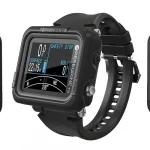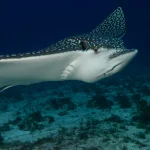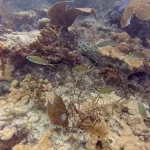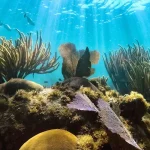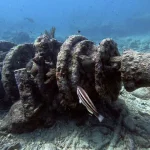Table of Contents
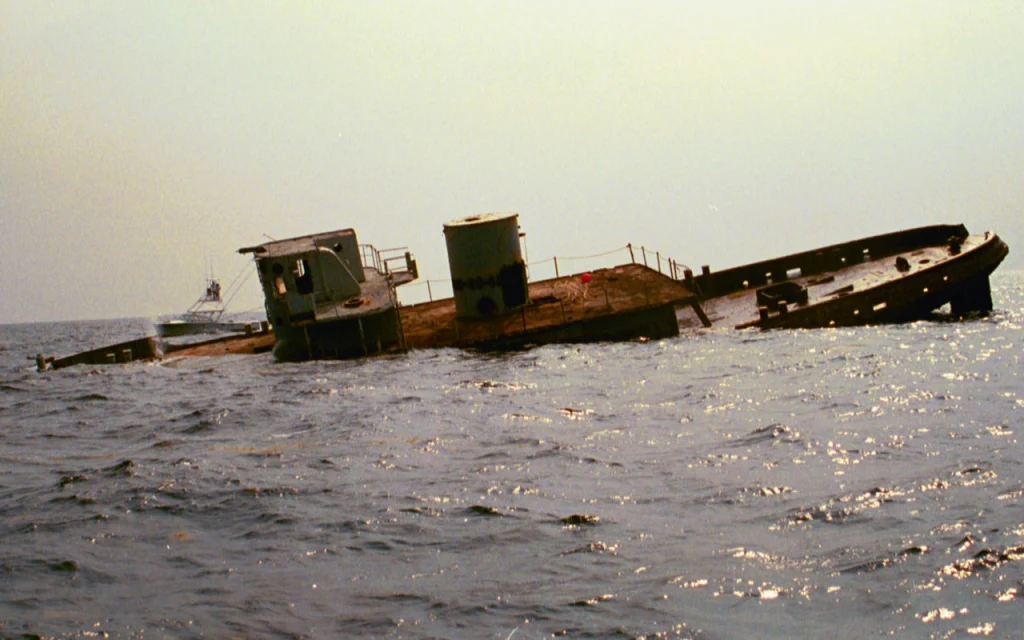
The USS Accokeek provides a blend of historical interest, ecological diversity, and technical diving challenges, making it a unique and popular destination for experienced divers.
Article at a Glance
- Historical Significance: The USS Accokeek, commissioned in 1944, served as a fleet tug during World War II, participating in crucial operations, including the invasion of Okinawa.
- Transformation to Artificial Reef: After decommissioning in 1972, the ship was repurposed as a training vessel and eventually sunk in 2000 to create an artificial reef off Panama City Beach, Florida.
- Diving Depth: The wreck lies at a depth of 100 feet (30.5 meters), making it an advanced dive site suitable for experienced divers.
- Unique Features: Divers can explore the well-preserved structure, including swim-through areas and portholes that offer views into the ship’s interior.
- Marine Ecosystem: As an artificial reef, the USS Accokeek has developed into a thriving habitat for various marine species, attracting divers and marine life alike.
- Location Coordinates: The wreck is located at coordinates 29° 58.475′ N, 085° 51.915′ W, making it part of the Florida Panhandle Shipwreck Trail.
- Diving Opportunities: Several dive shops in Panama City Beach offer trips to the USS Accokeek, providing guided dives and equipment rentals for enthusiasts looking to explore this historical site.
Shipwreck Location Coordinates and Depth
Depth
The wreck’s depth ranges from 74 feet at the bow to 100 feet at the sand
Location Coordinates
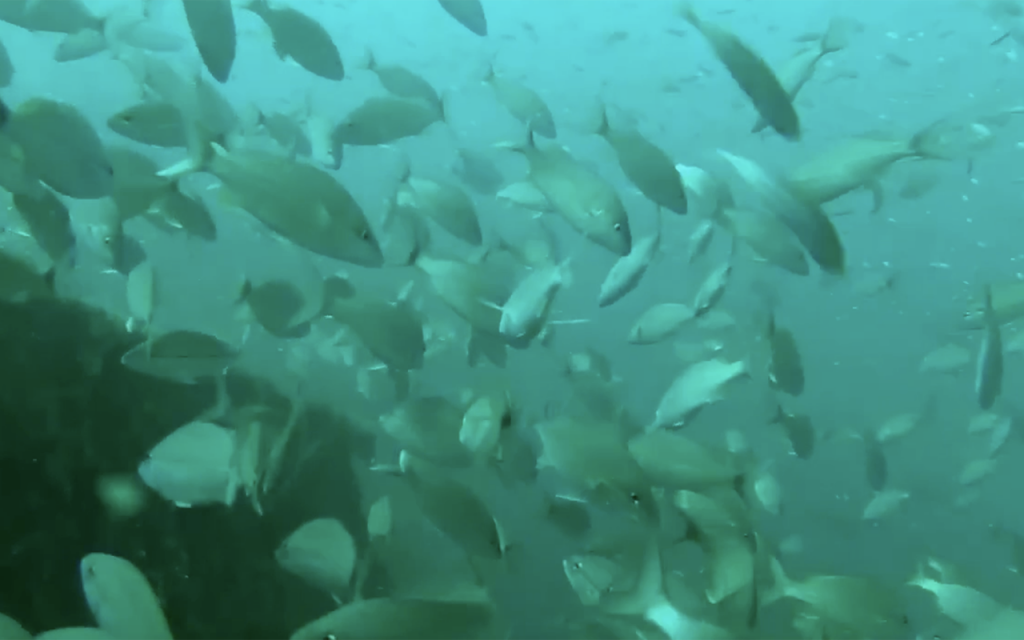
What Do Scuba Divers Say About This Ship
Dive Experience
- The Accokeek is considered an advanced dive due to its depth, ranging from 74 feet at the bow to 100 feet at the sand.
- Divers recommend using nitrox to extend bottom time at these depths.
- When visibility is good (60-80 feet), divers describe it as an “awesome site to dive and explore”.
Interesting Features
- There are cool portholes to look into.
- The wreck has a couple of swim-through areas.
- Divers can explore different levels, including the wheelhouse (57 feet deep), bow (77 feet), secondary deck (81 feet), and stern deck (85 feet).
Marine Life
- The wreck attracts “tons of life”.
- Many different species of fish make the Accokeek their home.
- Spearfishers note that the 25-foot vertical profile often holds amberjack.
Popularity
- One diving instructor reports taking hundreds of advanced student divers to this wreck.
- Divers frequently return to dive the Accokeek multiple times, sometimes bringing their older children to experience it.
- It’s described as an “exciting wreck” that leaves divers without complaints.
What Kind of Marine Life Can Be Found on The Ship
General Marine Life
Fish Species
Reef Ecosystem
As an artificial reef, the USS Accokeek likely supports a diverse ecosystem typical of Gulf of Mexico shipwrecks:
- Various reef fish species
- Invertebrates such as corals, sponges, and crustaceans
- Possibly larger pelagic fish that visit the site
Key Information
| Attribute | Details |
|---|---|
| Type | Auxiliary ocean tug (ATA-174 class) |
| Namesake | Accokeek tribe of Native Americans |
| Ordered | August 16, 1943 |
| Builder | Levingston Shipbuilding, Orange, Texas |
| Laid down | June 15, 1944 |
| Launched | July 27, 1944 |
| Commissioned | October 7, 1944 |
| Decommissioned | June 29, 1972 |
| Sunk as artificial reef | July 9, 2000 |
| Current location | Off Panama City Beach, Florida |
| Coordinates | 29° 58.475′ N, 085° 51.915′ W |
| Depth | 100 feet (30.5 meters) |
| Length | 143 feet (43.6 meters) |
| Beam | 33 feet 10 inches (10.31 meters) |
| Service history | World War II, post-war operations, training vessel |
| Notable features | Intact structure, swim-throughs, portholes |
| Current use | Artificial reef, advanced dive site |
What Makes The USS Accokeek Shipwreck a Unique Diving Experience
Historical Significance
- Built in 1944, the Accokeek served for 26 years as a fleet tug
- Participated in significant operations like the invasion of Okinawa and transited the Panama Canal
- Has a rich history of assisting various naval vessels along the East Coast and in international waters
Diverse Depth Profile
- The wreck sits at depths ranging from 74 feet at the bow to 100 feet at the sand
- Different levels offer varied exploration opportunities:
- Wheelhouse top: 57 feet
- Bow: 77 feet
- Secondary deck: 81 feet
- Stern deck: 85 feet
Intact Structure
- Relatively well-preserved structure allows for immersive exploration
- Features cool portholes to look into
- Offers a couple of swim-through areas
Thriving Artificial Reef
- Sunk in 2000, it has developed into a rich ecosystem
- Supports “tons of life,” including many different fish species
- Known to attract amberjack, making it popular for spearfishing
Technical Diving Opportunities
- Depth and structure make it suitable for advanced divers
- Recommended use of nitrox to extend bottom time
Photography Subject
- Combination of historical structure and marine life offers excellent photography opportunities
Part of a Larger Experience
- Component of the Florida Panhandle Shipwreck Trail, allowing divers to explore multiple wrecks in the region
How Does The USS Accokeek Compare to Other Shipwrecks in Florida
USS Accokeek
- Type: Fleet tug (ATA 181)
- Built: 1944
- Sunk: 2000 as an artificial reef
- Depth: 100 feet
- Length: 143 feet
- Features: Intact structure, swim-throughs, cool portholes, resident goliath grouper, thriving artificial reef ecosystem
Compared to Other Wrecks
USS Oriskany
- Much larger (888 feet vs 143 feet)
- Deeper range (80-212 feet vs 100 feet)
- More extensive exploration opportunities due to size
- Both are artificial reefs, but Oriskany is newer (sunk 2006)
USS Strength
- Similar depth (80-100 feet)
- Slightly longer (184 feet vs 143 feet)
- Less intact than Accokeek
- Both offer rich marine life
Black Bart
- Similar depth (80 feet)
- Longer (185 feet vs 143 feet)
- Lost its wheelhouse to Hurricane Michael
- Both offer swim-through opportunities
Vamar
- Much shallower (25 feet vs 100 feet)
- Scattered wreckage vs intact structure of Accokeek
- Offers historical significance (mysterious sinking)
Empire Mica
- Wider depth range (25-105 feet)
- Much longer (479 feet vs 143 feet)
- Older wreck (sunk 1942 vs 2000)
- More deteriorated over time
The USS Accokeek stands out for its intact structure, diverse features like portholes and swim-throughs, and thriving ecosystem despite being a relatively recent artificial reef. Its depth makes it suitable for advanced divers, similar to several other wrecks on this list.
What is The Full History of This Ship
Construction and Commissioning
- Laid down on June 15, 1944, in Orange, Texas by Levingston Shipbuilding
- Launched on July 27, 1944
- Commissioned on October 7, 1944, as USS ATA-181
World War II Service (1944-1946)
- Transited the Panama Canal in January 1945
- Arrived at Guam on March 25, 1945, just before the Okinawa campaign
- Aided damaged warships during the Okinawa campaign, towing them to safety
- Earned one battle star for World War II service
Post-War Pacific Service
- Provided towing and salvage support for American occupation forces
- Survived a severe typhoon at Okinawa on October 15, 1945, despite running aground
Atlantic Fleet Service (1946-1972)
- Arrived in Philadelphia on November 20, 1946
- Renamed USS Accokeek on July 16, 1948
- Operated primarily along the eastern seaboard and in the West Indies
- Missions included operations in Labrador, Ascension Island, and Lake Michigan
- Assisted various naval vessels, including cruisers and submarines
- Home port changed from Philadelphia to Little Creek, Virginia on June 30, 1969
Decommissioning and Initial Disposal
- Decommissioned on June 29, 1972, at Norfolk Naval Shipyard
- Transferred to the Maritime Administration on September 19, 1972
- Placed in the National Defense Reserve Fleet
- Stricken from the Naval Vessel Register on March 31, 1986
Naval Diving and Salvage Training Center
- In 1987, transferred to the Naval Diving and Salvage Training Center in Panama City, Florida
- Used as a training platform for salvage operations
- Repeatedly sunk and refloated for training purposes
Final Fate
- In summer 2000, CMDR. Mark Helmkamp, Commanding Officer of the Naval Diving and Salvage Training Center, secured a replacement training hull
- Turned over to the local artificial reef program in Panama City, Florida
- Sunk as an artificial reef on July 9, 2000, off the coast of Panama City Beach, Florida
- Now part of the Florida Panhandle Shipwreck Trail
- Rests at a depth of 100 feet (30.5 meters)
- Located at coordinates 29° 58.475′ N, 085° 51.915′ W
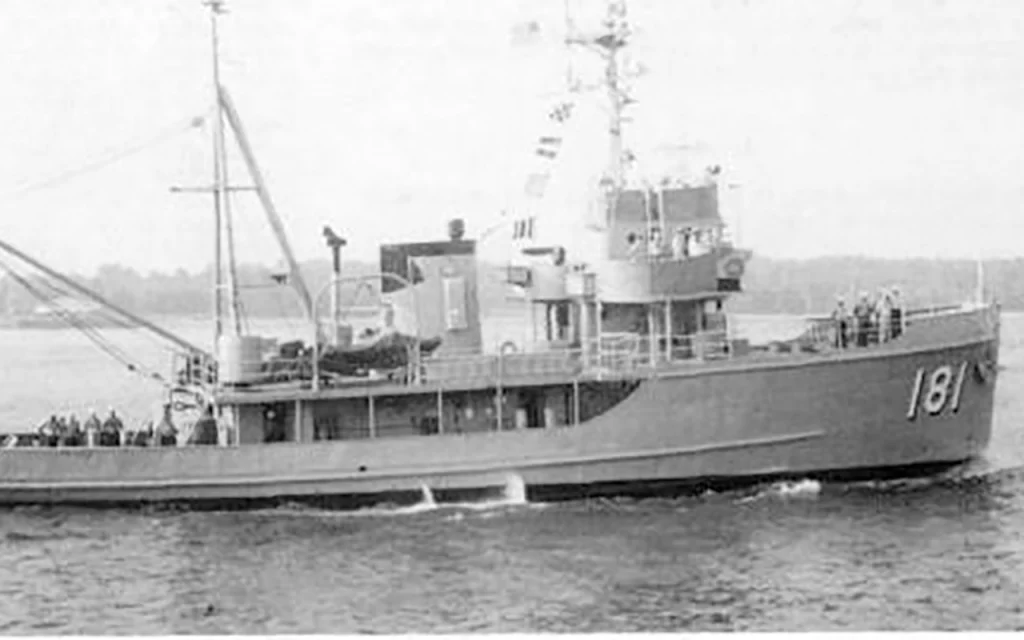
What Historical Features Can Still Be Identified on the USS Accokeek Wreck
Intact Structure
- The overall structure remains relatively intact, allowing divers to explore the ship’s layout and design
- The hull, deck, and various compartments are accessible for exploration
Distinctive Features
- Cool portholes that divers can look through, offering glimpses into the ship’s interior
- A couple of swim-through areas, allowing divers to navigate through the ship’s passageways and rooms
Depth Profile
- The wreck sits at depths ranging from 74 feet at the bow to 100 feet at the sand
- Different levels are identifiable:
- Wheelhouse top: 57 feet
- Bow: 77 feet
- Secondary deck: 81 feet
- Stern deck: 85 feet
Ship Characteristics
- The 143-foot length of the ship is still apparent
- The 33-foot 10-inch beam (width) can be observed
Historical Context
- The wreck’s structure reflects its original purpose as a fleet tug, with features typical of its class
- Its intact state allows divers to appreciate the design of World War II era naval auxiliary vessels
What Safety Measures Are in Place for Divers Visiting the USS Accokeek
- Depth awareness: The wreck rests at depths ranging from 74 feet at the bow to 100 feet at the sand. Divers must be aware of these depths and plan their dive accordingly to avoid decompression sickness.
- Advanced certification requirement: Given the depth, this is considered an advanced dive. Dive operators likely require divers to have advanced open water certification or equivalent experience.
- Nitrox recommendation: The use of nitrox is suggested to extend bottom time safely at these depths.
- Proper dive planning: Setting maximum depth and time limits is crucial for safety.
- Buddy system: As with most wreck dives, a buddy system is likely enforced to ensure diver safety.
- Guided dives: Many dive operators probably offer guided dives to the wreck, providing an extra layer of safety and expertise.
- Swim-through precautions: Since the wreck offers swim-through areas, divers are likely briefed on proper techniques and potential hazards associated with penetrating the wreck.
- Marine life awareness: With the presence of large marine life, divers are probably advised on proper behavior around these animals.
- Standard emergency procedures: The use of dive computers, safety stops, and proper ascent rates would be emphasized.
- Weather and current checks: Given its location in open water, dive operators likely monitor weather conditions and currents to ensure safe diving conditions.
Dive Shops That Provide Diving Trips to This Shipwreck
- Panama City Diving
- Offers guided tours and equipment rental
- Provides PADI certification courses
- Diver’s Den
- Employs experienced boat captains and divemasters
- Offers trips to various shipwrecks in the area
- Panama City Dive Center
- Established in 1983
- Provides dive training, equipment rental, and repair services
- Red Alert Diving
- Full-service dive center and aquatic training facility
- Has expert instructors with over 50 years of experience
North Florida Wrecks
- USS Oriskany
- USS Massachusetts
- SS Tarpon
- SS Gulf America
- Empire Mica
- USS Chippewa
- Avocet
- Black Bart
- The Vamar
- San Pablo
- USS Narcissus
- The Loftus Wreck
- The Dorothy Louise
- The Mizpah
- MV Janet
- The Eidsvag
- YDT-14 and YDT-15
- USS Strength
- Miss Louise
- The Lulu
- PC-1174
- Three Coal Barges
- USS Accokeek (ATA-181)
- El Dorado
- The Grey Ghost
- The Pete Tide II
- Red Sea Tug

